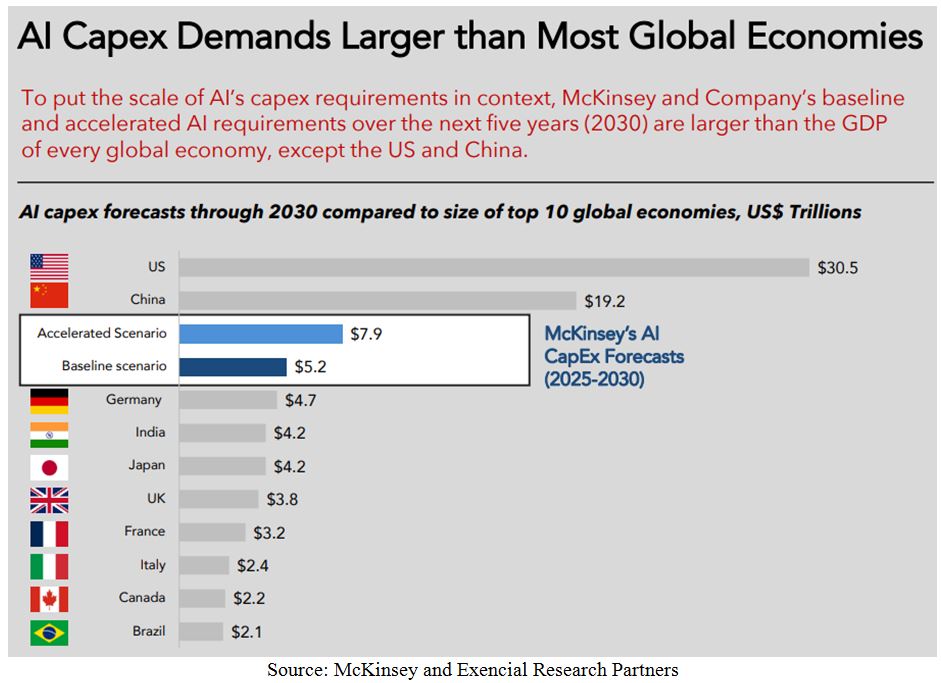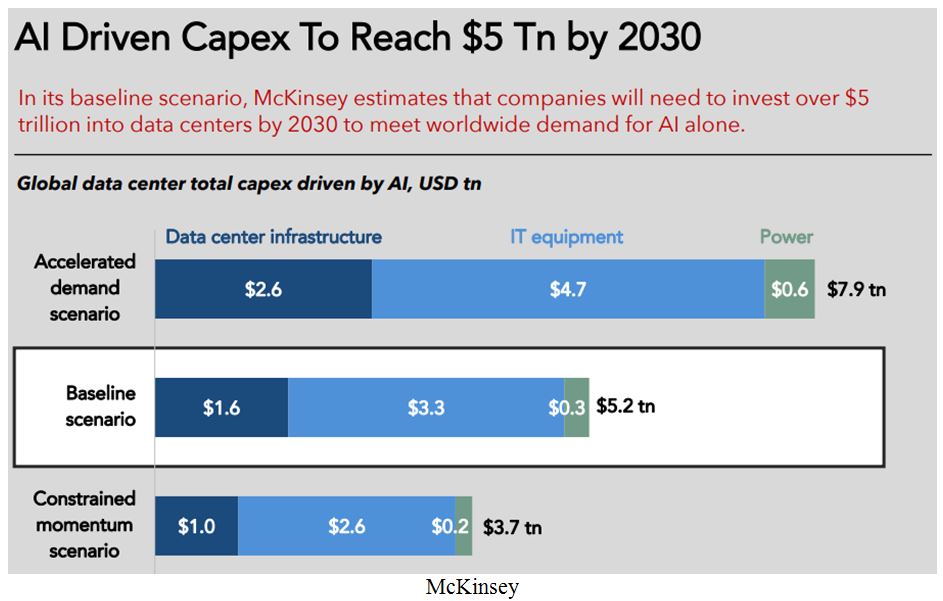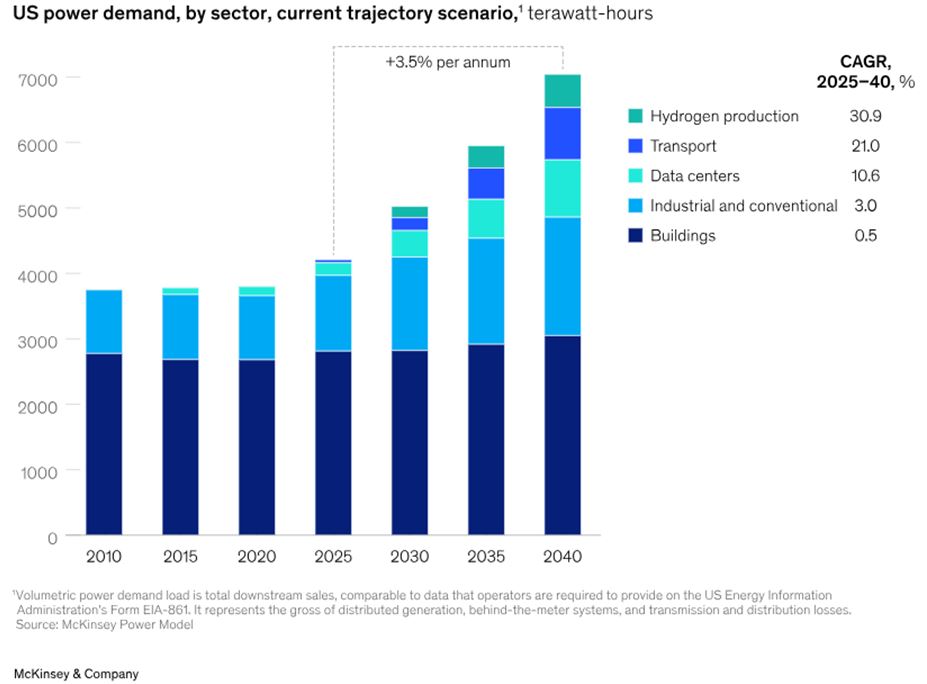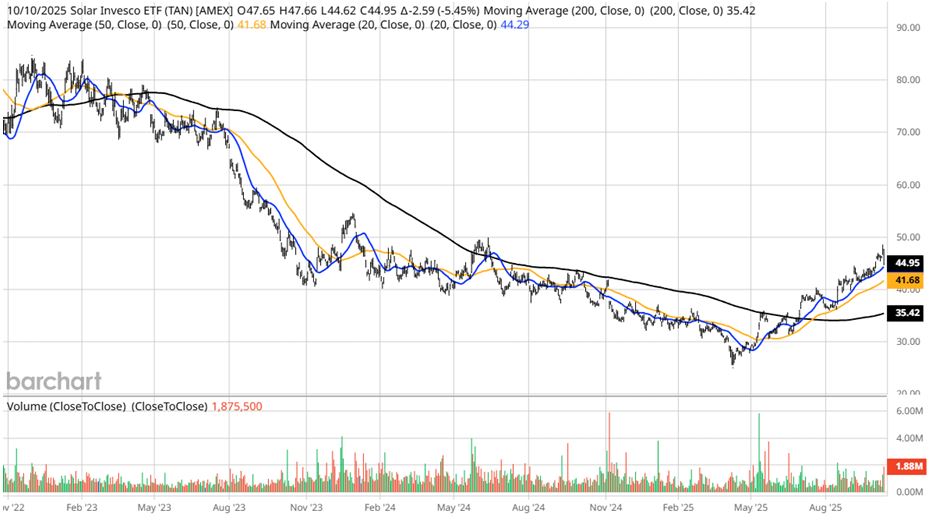by Bryan Perry
October 14, 2025
The current market flush, triggered by the Trump administration’s threat of additional 100% tariffs on China due to fresh export restrictions on rare-earth metals – of which China controls 70% of the global supply – has provided a much-needed moment of consolidation in an over-bought market, but I feel we remain in a long-term bull trend. This is a “pause that refreshes,” giving investors a chance to initiate (or add to) their slice of the pie in the top investment themes heading into year-end 2025, and then into 2026.
The most prominent themes driving investor attention now continue to be AI infrastructure and productivity, with the continued announcement of eye-watering capital commitments that cross the tape on an almost daily basis. While hype surrounding various AI applications is wide-ranging, I tend to focus mostly on semiconductors, data-centers, and cloud-platforms, where demand remains strong.

Graphs are for illustrative and discussion purposes only. Please read important disclosures at the end of this commentary.
It seems like every day we can read new stories about how the financial media equates the AI revolution with the bubble of the 1999 “dot-com era,” where hundreds of companies that that adopted a “.com” domain and a good sales pitch went bankrupt in sudden fashion in the year 2000 and thereafter, but I want to make it clear to investors that the AI transformation differs from the dot-com era because it’s built on mature infrastructure, real-world usage and proven demand, whereas the dot-com boom was largely speculative, on zero-earnings, with many companies lacking viable products or business models.
In the late 1990s, the internet was new, and infrastructure (broadband, cloud, mobile) was still primitive. Many startups were built on hype, not capability. AI is built on decades of research, with robust cloud-platforms, GPUs, and data pipelines already in place. Tools like ChatGPT, Copilot, Gemini and enterprise AI platforms are already deployed at scale, fueled by capital from the mightiest companies in the world.
By 2030, the U.S. is expected to host thousands of data-centers, with hyper-scale and colocation facilities driving exponential growth, though no single source can yet provide an exact count. McKinsey has put out some forecasts, stating that global investment in data-center infrastructure is projected to reach $7-trillion by 2030, with over 40% of that total allocated to the U.S., or roughly $2.8-trillion.

Graphs are for illustrative and discussion purposes only. Please read important disclosures at the end of this commentary.
Grandview Research reports that the U.S. data-center market is forecast to reach $164.7-billion in revenue by 2030, up from $89.9-billion in 2024, yielding a Compounded Annual Growth Rate (CAGR) of 10.6%. Using the baseball timeline, so constantly being thrown around, the AI infrastructure build-out appears to be in the 3rd or 4th inning of a 9-inning game, when capital deployment is accelerating but foundational systems are still being scaled and optimized to provide ample computer power and higher throughput.
This analysis coincides with the need for rapid expansion of the electric-grid and the wealth-building opportunities within the engineering-construction sector, where backlogs, sales and earnings are booming.
Much of the U.S. electric-grid was built in the 1960s and 1970s, so the grid is undergoing a much-needed generational overhaul. Upgrading 70% of aging infrastructure is essential not just for reliability, but to enable the AI build-out, electrification and clean-energy transition. The vast majority of transmission lines are approaching the end of their typical 50-to-80-year lifecycle, and McKinsey projects that U.S. power demand will grow by over 3% annually through 2040, requiring massive capacity expansion.

Graphs are for illustrative and discussion purposes only. Please read important disclosures at the end of this commentary.
Natural gas is still the largest source of electricity today (~40% of U.S. generation), providing reliable base-load and peak-power. Modern combined-cycle plants are efficient and relatively quick to build. Gas is abundant domestically, making it a stabilizing “bridge-fuel” for the grid through at least the 2030s.
However, the greatest future fuel for U.S. grid expansion will likely be solar energy, complemented by wind and backed by natural gas for reliability, with nuclear SMRs and green-hydrogen emerging as long-term strategic additions. Solar power is by far the fastest-growing source of new capacity. Utility-scale solar costs have dropped by over 80% in the past decade. The U.S. Energy Information Administration (EIA) expects solar to account for over 50% of new generating capacity added through 2030.
The price action for the solar sector has picked up after a steep multi-year decline, as charted below:

Graphs are for illustrative and discussion purposes only. Please read important disclosures at the end of this commentary.
What seems clear throughout this whole AI experience is that the biggest players in this space are widening their “moats” (well-protected competitive advantages). AI is wildly expensive to deploy at scale. Using market pullbacks to accumulate shares of the top Who’s Who among the AI infrastructure and applications companies is the way forward to continued capital appreciation of portfolios.
Aside from AI, the power-grid, gold, autonomous driving, robotics, quantum-computing, nuclear-power and cryptocurrencies all represent highly desirable areas of capital concentration for diversification in a market that is broadening out. The innovation coming from AI and these future technologies, along with Fed easing, are structural tailwinds that won’t be stopped by a geopolitical dispute over rare-earth metals.
We are at the start of an exciting fourth-quarter, which is shaping up to be a contrast of headline-driven selling pressures with buying opportunities, offering long-term investors an opportunity to partake in one of the most compelling generational wealth-building growth cycles in stock market history.
All content above represents the opinion of Bryan Perry of Navellier & Associates, Inc.
Also In This Issue
A Look Ahead by Louis Navellier
Global Turmoil is Rising Among Other Major Governments
Income Mail by Bryan Perry
A Chance to Buy “Wide Moat” AI Leaders after a Market Flush
Growth Mail by Gary Alexander
Is the Fed Really Independent…or Necessary?
Global Mail by Ivan Martchev
Two Tweets Totaling $2-Trillion (aka, “The Sun Tzu Sell-Off”)
Sector Spotlight by Jason Bodner
Caution: Turbulence Ahead (Safe Landings, Too)
View Full Archive
Read Past Issues Here

Bryan Perry
SENIOR DIRECTOR
Bryan Perry is a Senior Director with Navellier Private Client Group, advising and facilitating high net worth investors in the pursuit of their financial goals.
Bryan’s financial services career spanning the past three decades includes over 20-years of wealth management experience with Wall Street firms that include Bear Stearns, Lehman Brothers and Paine Webber, working with both retail and institutional clients. Bryan earned a B.A. in Political Science from Virginia Polytechnic Institute & State University and currently holds a Series 65 license. All content of “Income Mail” represents the opinion of Bryan Perry
Important Disclosures:
Although information in these reports has been obtained from and is based upon sources that Navellier believes to be reliable, Navellier does not guarantee its accuracy and it may be incomplete or condensed. All opinions and estimates constitute Navellier’s judgment as of the date the report was created and are subject to change without notice. These reports are for informational purposes only and are not a solicitation for the purchase or sale of a security. Any decision to purchase securities mentioned in these reports must take into account existing public information on such securities or any registered prospectus.To the extent permitted by law, neither Navellier & Associates, Inc., nor any of its affiliates, agents, or service providers assumes any liability or responsibility nor owes any duty of care for any consequences of any person acting or refraining to act in reliance on the information contained in this communication or for any decision based on it.
Past performance is no indication of future results. Investment in securities involves significant risk and has the potential for partial or complete loss of funds invested. It should not be assumed that any securities recommendations made by Navellier. in the future will be profitable or equal the performance of securities made in this report. Dividend payments are not guaranteed. The amount of a dividend payment, if any, can vary over time and issuers may reduce dividends paid on securities in the event of a recession or adverse event affecting a specific industry or issuer.
None of the stock information, data, and company information presented herein constitutes a recommendation by Navellier or a solicitation to buy or sell any securities. Any specific securities identified and described do not represent all of the securities purchased, sold, or recommended for advisory clients. The holdings identified do not represent all of the securities purchased, sold, or recommended for advisory clients and the reader should not assume that investments in the securities identified and discussed were or will be profitable.
Information presented is general information that does not take into account your individual circumstances, financial situation, or needs, nor does it present a personalized recommendation to you. Individual stocks presented may not be suitable for every investor. Investment in securities involves significant risk and has the potential for partial or complete loss of funds invested. Investment in fixed income securities has the potential for the investment return and principal value of an investment to fluctuate so that an investor’s holdings, when redeemed, may be worth less than their original cost.
One cannot invest directly in an index. Index is unmanaged and index performance does not reflect deduction of fees, expenses, or taxes. Presentation of Index data does not reflect a belief by Navellier that any stock index constitutes an investment alternative to any Navellier equity strategy or is necessarily comparable to such strategies. Among the most important differences between the Indices and Navellier strategies are that the Navellier equity strategies may (1) incur material management fees, (2) concentrate its investments in relatively few stocks, industries, or sectors, (3) have significantly greater trading activity and related costs, and (4) be significantly more or less volatile than the Indices.
ETF Risk: We may invest in exchange traded funds (“ETFs”) and some of our investment strategies are generally fully invested in ETFs. Like traditional mutual funds, ETFs charge asset-based fees, but they generally do not charge initial sales charges or redemption fees and investors typically pay only customary brokerage fees to buy and sell ETF shares. The fees and costs charged by ETFs held in client accounts will not be deducted from the compensation the client pays Navellier. ETF prices can fluctuate up or down, and a client account could lose money investing in an ETF if the prices of the securities owned by the ETF go down. ETFs are subject to additional risks:
- ETF shares may trade above or below their net asset value;
- An active trading market for an ETF’s shares may not develop or be maintained;
- The value of an ETF may be more volatile than the underlying portfolio of securities the ETF is designed to track;
- The cost of owning shares of the ETF may exceed those a client would incur by directly investing in the underlying securities; and
- Trading of an ETF’s shares may be halted if the listing exchange’s officials deem it appropriate, the shares are delisted from the exchange, or the activation of market-wide “circuit breakers” (which are tied to large decreases in stock prices) halts stock trading generally.
Grader Disclosures: Investment in equity strategies involves substantial risk and has the potential for partial or complete loss of funds invested. The sample portfolio and any accompanying charts are for informational purposes only and are not to be construed as a solicitation to buy or sell any financial instrument and should not be relied upon as the sole factor in an investment making decision. As a matter of normal and important disclosures to you, as a potential investor, please consider the following: The performance presented is not based on any actual securities trading, portfolio, or accounts, and the reported performance of the A, B, C, D, and F portfolios (collectively the “model portfolios”) should be considered mere “paper” or pro forma performance results based on Navellier’s research.
Investors evaluating any of Navellier & Associates, Inc.’s, (or its affiliates’) Investment Products must not use any information presented here, including the performance figures of the model portfolios, in their evaluation of any Navellier Investment Products. Navellier Investment Products include the firm’s mutual funds and managed accounts. The model portfolios, charts, and other information presented do not represent actual funded trades and are not actual funded portfolios. There are material differences between Navellier Investment Products’ portfolios and the model portfolios, research, and performance figures presented here. The model portfolios and the research results (1) may contain stocks or ETFs that are illiquid and difficult to trade; (2) may contain stock or ETF holdings materially different from actual funded Navellier Investment Product portfolios; (3) include the reinvestment of all dividends and other earnings, estimated trading costs, commissions, or management fees; and, (4) may not reflect prices obtained in an actual funded Navellier Investment Product portfolio. For these and other reasons, the reported performances of model portfolios do not reflect the performance results of Navellier’s actually funded and traded Investment Products. In most cases, Navellier’s Investment Products have materially lower performance results than the performances of the model portfolios presented.
This report contains statements that are, or may be considered to be, forward-looking statements. All statements that are not historical facts, including statements about our beliefs or expectations, are “forward-looking statements” within the meaning of The U.S. Private Securities Litigation Reform Act of 1995. These statements may be identified by such forward-looking terminology as “expect,” “estimate,” “plan,” “intend,” “believe,” “anticipate,” “may,” “will,” “should,” “could,” “continue,” “project,” or similar statements or variations of such terms. Our forward-looking statements are based on a series of expectations, assumptions, and projections, are not guarantees of future results or performance, and involve substantial risks and uncertainty as described in Form ADV Part 2A of our filing with the Securities and Exchange Commission (SEC), which is available at www.adviserinfo.sec.gov or by requesting a copy by emailing info@navellier.com. All of our forward-looking statements are as of the date of this report only. We can give no assurance that such expectations or forward-looking statements will prove to be correct. Actual results may differ materially. You are urged to carefully consider all such factors.
FEDERAL TAX ADVICE DISCLAIMER: As required by U.S. Treasury Regulations, you are informed that, to the extent this presentation includes any federal tax advice, the presentation is not written by Navellier to be used, and cannot be used, for the purpose of avoiding federal tax penalties. Navellier does not advise on any income tax requirements or issues. Use of any information presented by Navellier is for general information only and does not represent tax advice either express or implied. You are encouraged to seek professional tax advice for income tax questions and assistance.
IMPORTANT NEWSLETTER DISCLOSURE:The hypothetical performance results for investment newsletters that are authored or edited by Louis Navellier, including Louis Navellier’s Growth Investor, Louis Navellier’s Breakthrough Stocks, Louis Navellier’s Accelerated Profits, and Louis Navellier’s Platinum Club, are not based on any actual securities trading, portfolio, or accounts, and the newsletters’ reported hypothetical performances should be considered mere “paper” or proforma hypothetical performance results and are not actual performance of real world trades. Navellier & Associates, Inc. does not have any relation to or affiliation with the owner of these newsletters. There are material differences between Navellier Investment Products’ portfolios and the InvestorPlace Media, LLC newsletter portfolios authored by Louis Navellier. The InvestorPlace Media, LLC newsletters contain hypothetical performance that do not include transaction costs, advisory fees, or other fees a client might incur if actual investments and trades were being made by an investor. As a result, newsletter performance should not be used to evaluate Navellier Investment services which are separate and different from the newsletters. The owner of the newsletters is InvestorPlace Media, LLC and any questions concerning the newsletters, including any newsletter advertising or hypothetical Newsletter performance claims, (which are calculated solely by Investor Place Media and not Navellier) should be referred to InvestorPlace Media, LLC at (800) 718-8289.
Please note that Navellier & Associates and the Navellier Private Client Group are managed completely independent of the newsletters owned and published by InvestorPlace Media, LLC and written and edited by Louis Navellier, and investment performance of the newsletters should in no way be considered indicative of potential future investment performance for any Navellier & Associates separately managed account portfolio. Potential investors should consult with their financial advisor before investing in any Navellier Investment Product.
Navellier claims compliance with Global Investment Performance Standards (GIPS). To receive a complete list and descriptions of Navellier’s composites and/or a presentation that adheres to the GIPS standards, please contact Navellier or click here. It should not be assumed that any securities recommendations made by Navellier & Associates, Inc. in the future will be profitable or equal the performance of securities made in this report.
FactSet Disclosure: Navellier does not independently calculate the statistical information included in the attached report. The calculation and the information are provided by FactSet, a company not related to Navellier. Although information contained in the report has been obtained from FactSet and is based on sources Navellier believes to be reliable, Navellier does not guarantee its accuracy, and it may be incomplete or condensed. The report and the related FactSet sourced information are provided on an “as is” basis. The user assumes the entire risk of any use made of this information. Investors should consider the report as only a single factor in making their investment decision. The report is for informational purposes only and is not intended as an offer or solicitation for the purchase or sale of a security. FactSet sourced information is the exclusive property of FactSet. Without prior written permission of FactSet, this information may not be reproduced, disseminated or used to create any financial products. All indices are unmanaged and performance of the indices include reinvestment of dividends and interest income, unless otherwise noted, are not illustrative of any particular investment and an investment cannot be made in any index. Past performance is no guarantee of future results.
